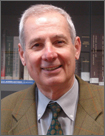221st ECS Meeting | Seattle, WA | May 7, 2012
Will It Be a Tank of Lithium to Drive Our Next Car?”
Back in 1800, when Alessandro Volta, professor at the University of Pavia in Italy, unveiled his “electric pile” to Napoleon Bonaparte, he could not have imagined that his invention—mainly the fruit of a dispute with his colleague-competitor Luigi Galvani at University of Bologna—would have opened a route that, via various progressive technological evolution steps, did eventually lead to the development of the electrochemical power source that today dominates the consumer electronics market. This is the lithium battery, currently produced at a rate of several billions of units per year. This talk will illustrate the evolution of these important energy storage devices, from their early stages to the present worldwide intense research activities aimed to further improve their properties and characteristics. Also discussed will be the various new electrode and electrolyte materials that are currently being investigated as a way to upgrade the energy content of the batteries so as to deal with the new challenges opened by the expected advent of a wide road electrification. Lithium batteries are facing a second, new age: as the first one led to the revolution in the consumer electronic market, the new one is expected to favor an epoch-making change in vehicle transportation.
Bruno Scrosati is Senior Professor of Electrochemistry at the University of Rome La Sapienza. In 1990 he was the George T. Piercy distinguished visiting professor in the Department of Chemical Engineering & Materials Science at the University of Minnesota, and in 1991 was a visiting professor in the Department of Chemical Engineering & Materials Science at the University of Pennsylvania. Presently, he is a visiting professor in the Department of Energy Engineering ar Hanyang University in Seoul, Korea. In 1990-92 he was President of the International Society of Solid State Ionics and in 1996-1998 President of the Italian Chemical Society. He was elected Vice-President (2000) and President (2003-2004) of The Electrochemical Society. In 1996 he received the title of Doctor in Science honoris causa, Hon. Dsc. from the University of St. Andrews in Scotland. In 1997 he received the ECS Battery Division Research Award. In 2004 he won the XVI edition of the Italgas Prize, noted for science and environment, specifically for “his studies, which provide consistent evidence that the new, morphologically optimized materials approach the performance levels requested for batteries and fuel cells designed for electric vehicle applications.” In 2005 he was named a Fellow of The Electrochemical Society and in 2007 a Fellow of the International Society of Electrochemistry. In 2006 he received the Volta Medal of the ECS European Section, and in 2007 the “Sigillo d’oro” Medal from the Italian Chemical Society. In 2008 he received an honorary doctorate in science and technology from the Chalmers University of Technology, Goteborg, Sweden.
Dr. Scrosati is the European editor of the Journal of Power Sources and a member of the editorial boards of various international journals, which include Solid State Ionics, Journal of Applied Electrochemistry, Progress in Solid State Chemistry, and the Journal of New Materials for Electrochemical Systems. Professor Scrosati has coordinated several national and international research projects devoted to the studies of materials for energy storage electrochemical devices. He was Chair of the 1st International Conference on Lithium Batteries (IMLB 1), the 1st International Conference on Polymer Batteries and Fuel Cells (PBFC 1), promoter and chair of the Japan-Italy-Germany Electrochemical Seminar, and of the Korea-Italy-Swedish Electrochemical Seminar. All these have become regular and established international events. He has been an invited speaker at many international conferences. Prof. Scrosati is author of more than 450 scientific publications, 30 books and chapters in books, and 18 patents. His H-factor is 48.
